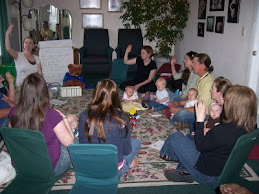Frequently Asked Questions about Baby Sign Language:
Will signing discourage my baby from learning to talk?Absolutely not! In fact, in a long-term Baby Signs study funded by the National Institute of Health and conducted at the University of California, we found the exact opposite to be true: Using signs actually makes it easier for babies to learn to talk. When we compared children who had been encouraged to use signs with children from the same areas who had not, we found that the signing babies consistently scored higher on standardized tests of both receptive language development (how much they understand) and expressive language development (how much they can say). Brain developmentCommunicating requires thinking, planning, and decision-making (e.g., "Hmm, is that a bird or a duck?"). Each one of these activities stimulates the developing brain in important ways that benefit the child the next time around. Because signing enables children to communicate at remarkably young ages, Baby Signs® babies enjoy a "jump start" in the development of the neural substrate of language.
Baby Signs® babies "pull" verbal language from adults: When babies use signs to call attention to things, adults quite naturally respond with lots of appropriate words (e.g., "Oh! You see a kitty! That is a kitty! That kitty looks just like our kitty, doesn't it!"). And we know that the more language a baby hears, the faster language acquisition proceeds.
Baby Signs® babies can pick the topic: We all find it easier to learn about things in which we are really interested. With signs at their disposal, babies can direct their parents' attention to objects they find fascinating rather than just listening to labels for things their parents think are important.
Using the Baby Signs® Program is fun! Just as learning to crawl is so exciting that it inspires babies to learn to walk, signing whets a baby's appetite for even better ways to communicate. In other words, the motivation to learn to talk actually increases rather than decreases when you encourage your baby to communicate with signs.
When should I start signing with my baby?
Whenever you'd like, but certainly by 8 or 9 months. Some families begin as soon as their baby is born just to get into the habit, and that's fine. After all, we talk to babies from the day they're born (or even earlier); we just don't worry when they don't answer! At about the time your baby can make sustained eye contact is the best time to start intensive Baby Signing.
When will my baby start signing back to me?The answer varies enormously from baby to baby depending on a child's interest in communicating (some babies prefer climbing bookshelves to reading books), development of related skills (e.g., memory, imitation, attention), and the frequency with which parents model the signs. The most typical age range for first signs is between 10 and 14 months. It's important to keep in mind that the younger the child is when you begin modeling - even within this age range - the longer it will take for those first few signs to appear. After that it's "off to the races!" Linda's son, Kai, for example, didn't produce his first sign until he was 12-months-old. However, once the proverbial "light bulb" came on, he added new signs very quickly – about 14 new signs within 3 weeks. Eventually Kai had a repertoire of over 40 signs which he used very productively until he hit his "verbal spurt" at 19 months (from 7 to 74 verbal words in a single month!).
My baby is 20 months old and has quite a few words. Is it too late to start?
Even babies with 50 to 100 word vocabularies still find some words too hard to say (e.g., hippopotamus, crocodile). As long as that's the case - no matter what the child's age - we've found that sign equivalents are welcomed.
Please see www.babysigns.com for more information
 I am a certified Baby Signs® Independent Instructor!
I am a certified Baby Signs® Independent Instructor!

